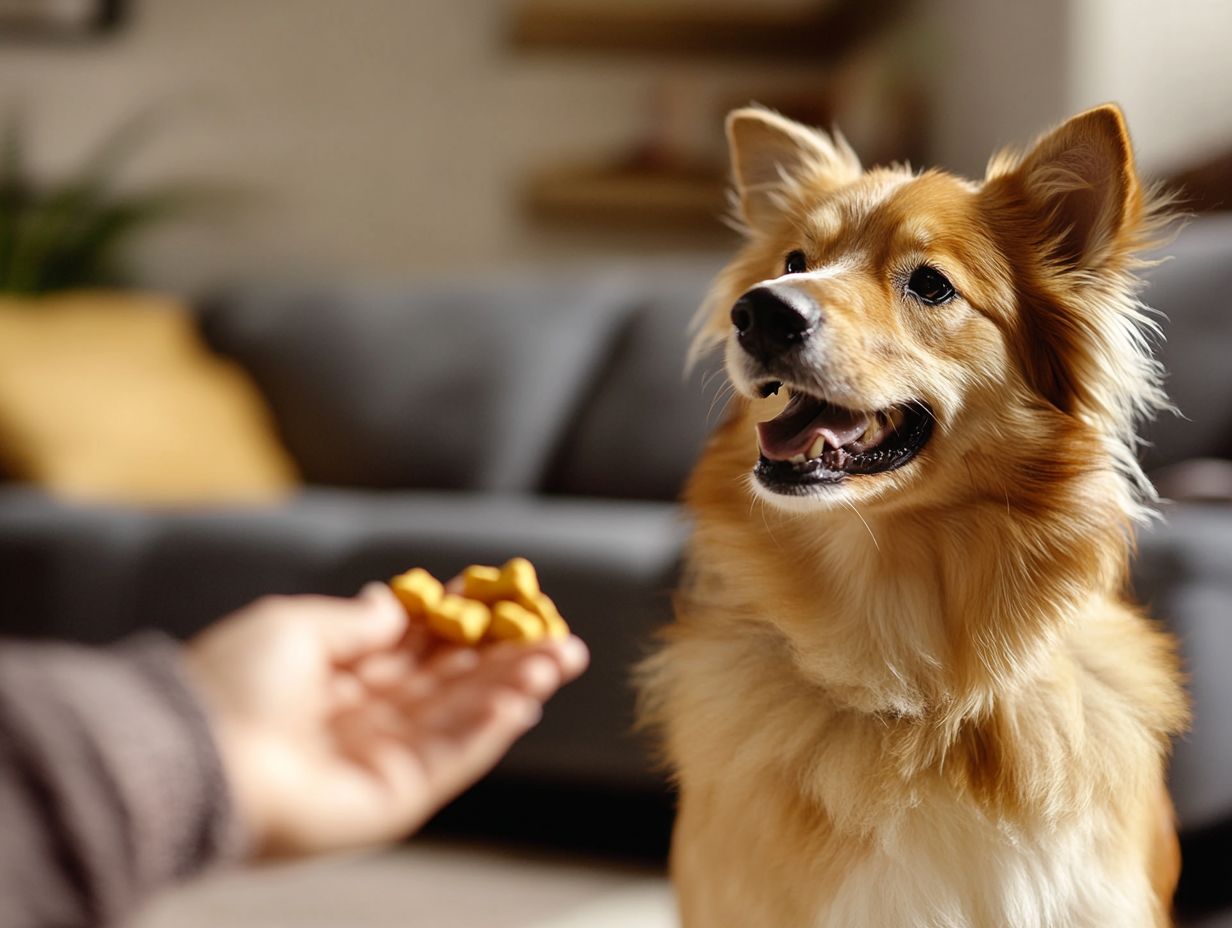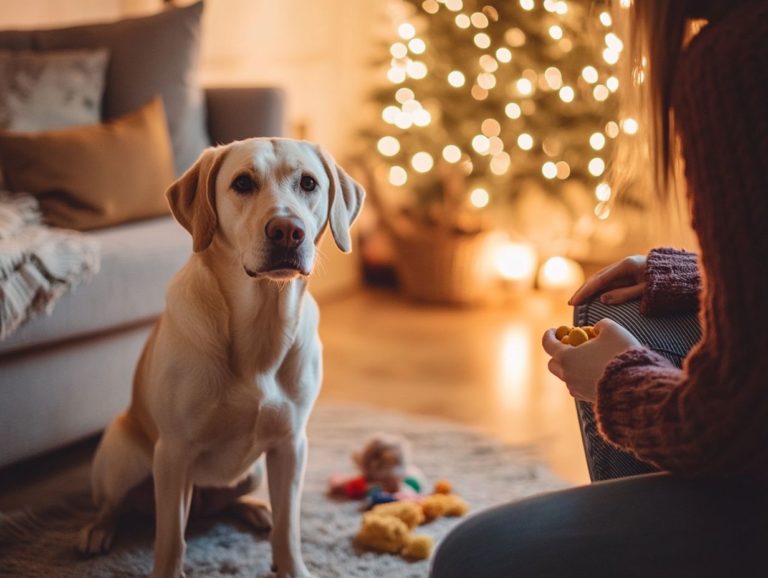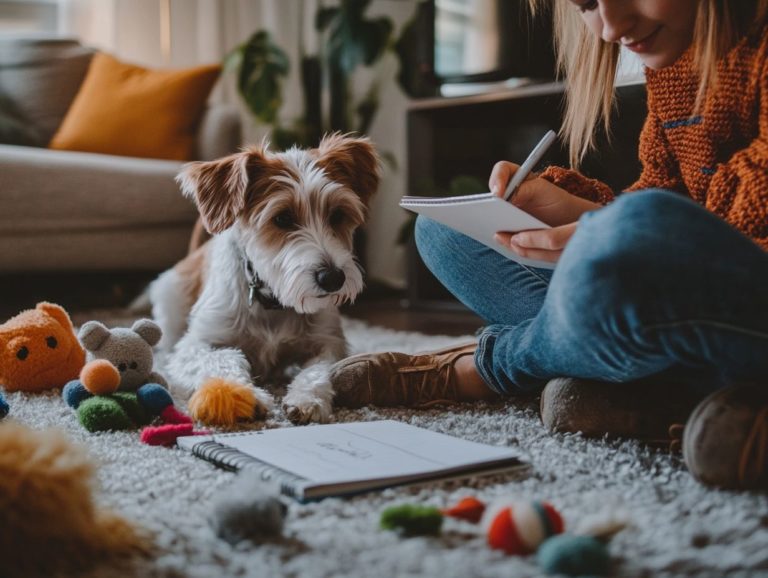Using Clicker Training to Alleviate Anxiety
Anxiety can weigh heavily on both pets and their owners, influencing daily routines and overall well-being.
To effectively address this challenge, it s crucial to understand the underlying causes and symptoms of anxiety. One increasingly popular method is clicker training, which is based on positive reinforcement.
This article delves into how clicker training can help reduce anxiety, providing you with a step-by-step guide and invaluable tips. Whether you re an experienced trainer or a worried pet owner, you ll uncover strategies to foster trust and confidence in your furry companion.
Contents
- Key Takeaways:
- Understanding Anxiety and Its Impact
- How Clicker Training Can Help with Anxiety
- Your Step-by-Step Guide to Clicker Training for Anxiety Relief!
- Additional Tips and Considerations
- Frequently Asked Questions
- What is clicker training and how can it help alleviate anxiety?
- What types of animals can benefit from clicker training for anxiety?
- Can clicker training replace medication for anxiety in animals?
- How long does it take to see results from using clicker training for anxiety?
- Are there any negative side effects of using clicker training for anxiety?
- Can clicker training be used for all types of anxiety in animals?
Key Takeaways:

- Discover how clicker training can transform your dog’s anxiety into confidence!
- Follow our step-by-step guide for effective training.
- Combine techniques for the best results in reducing anxiety.
Understanding Anxiety and Its Impact
Anxiety is a pervasive condition affecting millions, intricately intertwined with their mental well-being. It often manifests in various forms, including OCD, intrusive thoughts, and emotional discomfort.
Grasping the nuances of anxiety and its repercussions is essential for cultivating effective coping mechanisms. By doing so, you can confront the myriad challenges that accompany this condition in daily life.
Causes and Symptoms of Anxiety
Anxiety can arise from many sources, ranging from genetic predispositions to environmental stressors. This often leads to intrusive thoughts and emotional unease.
Understanding these causes is essential, as they frequently intertwine and amplify one another, leading to heightened anxiety levels. For example, if you have a family history of anxiety disorders, you might be more susceptible to these traits.
Biological factors, such as imbalances in brain chemistry, can also significantly influence emotional regulation. Environmental triggers like stressful life events or ongoing pressure from work and relationships can exacerbate existing symptoms.
You may notice common signs of anxiety, including restlessness, difficulty focusing, and even physical manifestations like a racing heartbeat. These symptoms can disrupt your daily life, underscoring the importance of addressing these challenges in a compassionate and supportive manner.
What is Clicker Training?
Clicker training is a simple training technique that uses a small handheld device to produce a distinct sound, marking desired behaviors in dogs and reinforcing them through positive reinforcement. This enhances dog behavior.
This innovative approach began in the 1940s when researchers explored operant conditioning a way to train pets by rewarding good behavior instead of punishing bad ones. By using this method, you can communicate effectively with your dog, helping them understand which actions are desirable.
Positive reinforcement not only motivates your canine companion but also strengthens the bond between you. This training technique is popular for addressing various behavioral issues, such as excessive barking, jumping, or anxiety.
The clear signals provided by the clicker guide your dog toward improved behavior, making the training process both effective and enjoyable for everyone involved.
How Clicker Training Can Help with Anxiety
Clicker training is a highly effective method for alleviating anxiety in dogs. By using positive reinforcement techniques and scent training to calm anxious pets, it promotes behavior modification and fosters a greater sense of security for your anxious canine companion.
Don t wait! Start using clicker training today to help your dog feel secure!
Positive Reinforcement Techniques

Positive reinforcement techniques are essential in dog training. They effectively encourage desired behaviors by using valuable rewards during training sessions to create strong associations.
For example, using treats, praise, or a favorite toy can significantly motivate your dog. This leads them to repeat actions that earn such rewards. This approach also fosters trust and strengthens the bond between you and your dog. It plays a crucial role in alleviating anxiety.
When dogs associate training sessions with positive experiences, they feel more secure and relaxed, which helps reduce fearful behaviors.
High-value rewards inject a sense of excitement into the process, making each training session enjoyable and stimulating. As a result, these techniques enhance obedience training while also contributing to your dog s overall well-being. They establish a solid foundation for lifelong positive behaviors and effective training techniques.
Building Trust and Confidence
Building trust and confidence in dogs is crucial for achieving positive outcomes in behavior training, especially when dealing with anxiety and fearfulness.
Establishing a strong bond through clear communication helps your dog understand expectations and feel secure in their environment. By employing consistent training methods like positive reinforcement and gentle encouragement, you can significantly reduce your anxious dog s stress.
Patience is key allowing your dog to progress at their own pace nurtures a sense of safety and trust.
Over time, these strategies enhance behavior and bolster your dog’s overall mental well-being. They help alleviate anxiety, paving the way for a more harmonious relationship between you and your pet.
Your Step-by-Step Guide to Clicker Training for Anxiety Relief!
This comprehensive guide to employing Clicker Training for anxiety will equip you with effective strategies and tailored training techniques. These are designed to tackle the specific behavioral challenges your dog may face, addressing both dog anxiety and behavior management.
Choosing the Right Clicker and Treats
Choosing the right clicker and treats is crucial for successful Clicker Training. High-value rewards can elevate your training sessions to new heights.
You ll find various clickers to suit your style, from traditional sound clickers to whistle clickers or even mobile app clickers. Each type offers unique advantages, depending on your dog s responsiveness and your own comfort level.
In terms of treats, select those that truly entice your dog. Whether it’s soft chews, crunchy kibble, or even morsels of cooked chicken, these delicious rewards can significantly boost their motivation.
By tailoring your choice of clicker and treats to your dog’s personality, you enhance their learning outcomes and help ease any anxiety they might experience during training. This thoughtful approach fosters a more positive and productive experience for both you and your furry friend.
Training Exercises for Anxiety Relief
Exciting training exercises designed for anxiety relief can empower your dog with crucial coping skills! These exercises help manage emotional discomfort and behavioral challenges, including leash pulling and toilet training.
These exercises are invaluable tools for building confidence and promoting calm behavior. For example, desensitization gradually getting your dog used to things that scare them can significantly reduce their fear response over time.
Incorporating basic commands like “sit” and “stay” can also help maintain focus during stressful moments. Engaging in regular physical activity through leash walking or interactive play is crucial. It helps burn off excess energy that might otherwise manifest as anxiety-fueled behavior.
The success of these training exercises relies on your commitment to consistent practice. Repetition fosters familiarity, creating a sense of security for your dog and enhancing the overall effectiveness of the training.
This dedication leads to greater emotional resilience for your furry friend and cultivates a more harmonious relationship between you both.
Additional Tips and Considerations

Incorporating additional tips and considerations into your Clicker Training regimen can greatly elevate your behavior management and enhance your overall training outcomes. This leads to effective training challenges being met.
Use Clicker Training with Other Techniques for Better Results
Combining clicker training with other therapies allows you to take a complete approach to helping your dog with anxiety. For a thorough understanding, you can explore the best practices for pet anxiety training, providing a comprehensive suite of behavior modification solutions that also includes command reinforcement.
This integration amplifies the effectiveness of your training. You can create a strong bond with your dog while training! For example, using desensitization techniques can help your dog gradually get used to what makes them anxious. Additionally, anxiety management strategies provide supportive tools for stressful situations.
By utilizing a variety of methods, you can customize your training programs to meet your dog’s unique needs. This leads to a more balanced emotional state and enhanced overall behavior in your beloved companion.
Monitor Progress and Adjust Techniques
Monitoring your progress and adjusting your techniques are vital for any successful Clicker Training program designed to manage anxiety in dogs.
To gauge how well the training is working, keep detailed records of each session. Note behaviors that highlight improvements or setbacks. Observing your dog’s body language can offer valuable insights. If they seem more relaxed or responsive, it’s a sign of progress. Conversely, signs of stress suggest it s time to rethink your approach.
Regularly reviewing these notes allows you to fine-tune your techniques. You might need to adjust the timing of your clicks or the frequency of treats. It s important to remain patient and consistent throughout this journey. Remember, meaningful changes often require time and repeated efforts to cement those new behaviors.
Frequently Asked Questions
What is clicker training and how can it help alleviate anxiety?
Clicker training is a form of positive reinforcement training that uses a small device making a distinct clicking sound to mark desired behaviors. It can help alleviate anxiety by providing a consistent and positive interaction between you and your pet. Additionally, using treats effectively in anxiety training builds trust and decreases anxious behaviors.
What types of animals can benefit from clicker training for anxiety?

Clicker training can be used on various animals, including dogs, cats, horses, birds, and even exotic animals like lizards and rabbits. Any animal that can learn and respond to positive reinforcement can benefit from clicker training for anxiety.
Can clicker training replace medication for anxiety in animals?
No, clicker training should never replace prescribed medication for anxiety in animals. It can be a complementary therapy to help manage anxiety, but always discuss it with a veterinarian first.
How long does it take to see results from using clicker training for anxiety?
The time to see results from clicker training can vary based on your animal’s individual needs and the consistency of training. Some animals may show improvement in a few weeks, while others may take longer. Patience and consistency are essential for positive results.
Are there any negative side effects of using clicker training for anxiety?
No known negative side effects of clicker training for anxiety exist. However, it’s important to use positive reinforcement techniques and never punish an animal during training, as this can worsen their anxiety.
Can clicker training be used for all types of anxiety in animals?
Clicker training can be effective for many types of anxiety in animals, such as separation anxiety, fear-based anxiety, and social anxiety. However, it may not be as effective for more severe cases. In such instances, consider using games to alleviate pet anxiety and consult with a professional if an animal’s anxiety is impacting their daily life.






